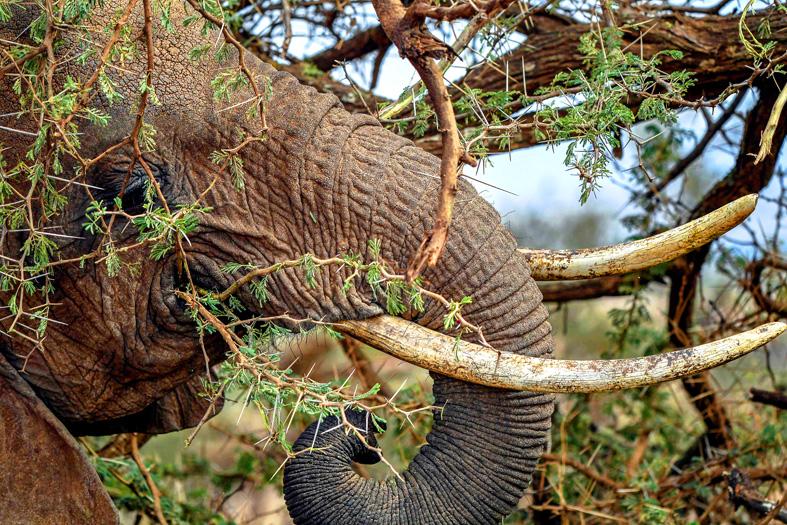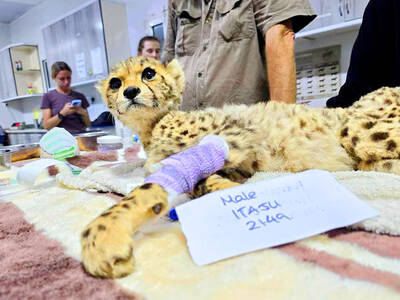The flimsy planes tethered to metal drums to prevent them from accidentally becoming airborne are unlikely weapons in Kenya’s fight to protect threatened species as it conducts its first national wildlife census.
Decades of poaching and expanding human settlements have taken a heavy toll on the global wildlife population and central Kenya is no exception.
African savanna elephants have been particularly hard-hit, with their numbers plunging by at least 60 percent during the past half-century, International Union for Conservation of Nature data showed.

Photo: AFP
So the pilots preparing their aircraft at the tiny airport at Isiolo know they are on the frontlines of a battle with far-reaching consequences.
“Elephants are the key animals, but when you are able to locate [any] endangered species, you feel like the census is on the right track,” pilot Chris Cheruiyot said as he fastened the safety belt of his passenger, Julius Kabete.
A camera and audio recorder dangling from his neck, Kabete spent the next few hours counting Somali giraffes, Grevy’s zebras, oryxes and other animals as the pair cruised the windy skies and refuel their two-seater Aviat Husky aircraft at specially set up stations in the forest.
The ambitious exercise, which began in May, covers major species in more than 50 of Kenya’s national parks and reserves, as well as private and community conservancies, and includes marine life.
Much of the existing data on the country’s wildlife population are gathered individually by local advocacy groups or international conservationists, contributing to a scattershot approach to animal protection.
Furthermore, training spotters is often time-consuming and expensive.
The result is that many scientists prefer to use models to map wildlife instead of tracking animals in the flesh, said zoologist Iain Douglas-Hamilton of Save the Elephants.
“They publish modeled results [rather] than raw data,” Douglas-Hamilton said.
That makes this maiden census especially important. Its information would help the east African nation map a long-term strategy to save a cherished asset that is also a major tourist draw.
However, numbers tell only half the story. For the rest, the spotters need to track the animals’ habits — where they eat, drink and rest.
At a hotel in Isiolo, a team listens to audio files chronicling a day’s work.
The preliminary data are already “very worrying,” said Fred Omengo, a scientist with the Kenya Wildlife Service (KWS), adding that many of the animals were spotted around watering holes close to people’s homes, a sign of extensive human encroachment into wildlife territory.
“The little [food] that is available is basically a competition between domestic and wild animals,” Omengo said. “In most cases, domestic animals will have an upper hand.”
As humans attempt to fence out wildlife, both are paying a deadly price.
Nearly 500 people were mauled or crushed to death by wild animals from 2014 to 2017, the KWS said in a report published in December 2019.
More recent figures were not available.
The threat to humanity and to wildlife is only set to intensify, conservationists warn.
“All wildlife routes have been closed by humans and now elephants want water, know where it is, but can’t get there. This is a worry,” Robert Obrein of KWS said.
“We have encroached into areas we have never been [in] before, and the numbers are growing. That means in another 10 years, we might not be having wildlife outside protected areas,” he said.
It is a fear not lost on the census takers, whose patient, painstaking efforts are often cut short by poor weather.
As sharp gusts send clouds of dust flying into the atmosphere, diminishing visibility to less than 500m, the three pilots circled back for home after a four-hour mission, accepting defeat for now.
The aircraft are “inherently unstable” and too light to tackle high winds, Kennedy Shamala said.
“You are flying below 500 feet [150m] above ground level, so you have minimum altitude to play with,” the soft-spoken pilot said. “You are working throughout, both your legs and hands and observing.”

ELECTION DISTRACTION? When attention shifted away from the fight against the militants to politics, losses and setbacks in the battlefield increased, an analyst said Recent clashes in Somalia’s semi-autonomous Jubaland region are alarming experts, exposing cracks in the country’s federal system and creating an opening for militant group al-Shabaab to gain ground. Following years of conflict, Somalia is a loose federation of five semi-autonomous member states — Puntland, Jubaland, Galmudug, Hirshabelle and South West — that maintain often fractious relations with the central government in the capital, Mogadishu. However, ahead of elections next year, Somalia has sought to assert control over its member states, which security analysts said has created gaps for al-Shabaab infiltration. Last week, two Somalian soldiers were killed in clashes between pro-government forces and

Ten cheetah cubs held in captivity since birth and destined for international wildlife trade markets have been rescued in Somaliland, a breakaway region of Somalia. They were all in stable condition despite all of them having been undernourished and limping due to being tied in captivity for months, said Laurie Marker, founder of the Cheetah Conservation Fund, which is caring for the cubs. One eight-month-old cub was unable to walk after been tied up for six months, while a five-month-old was “very malnourished [a bag of bones], with sores all over her body and full of botfly maggots which are under the

BRUSHED OFF: An ambassador to Australia previously said that Beijing does not see a reason to apologize for its naval exercises and military maneuvers in international areas China set off alarm bells in New Zealand when it dispatched powerful warships on unprecedented missions in the South Pacific without explanation, military documents showed. Beijing has spent years expanding its reach in the southern Pacific Ocean, courting island nations with new hospitals, freshly paved roads and generous offers of climate aid. However, these diplomatic efforts have increasingly been accompanied by more overt displays of military power. Three Chinese warships sailed the Tasman Sea between Australia and New Zealand in February, the first time such a task group had been sighted in those waters. “We have never seen vessels with this capability

‘NO INTEGRITY’: The chief judge expressed concern over how the sentence would be perceived given that military detention is believed to be easier than civilian prison A military court yesterday sentenced a New Zealand soldier to two years’ detention for attempting to spy for a foreign power. The soldier, whose name has been suppressed, admitted to attempted espionage, accessing a computer system for a dishonest purpose and knowingly possessing an objectionable publication. He was ordered into military detention at Burnham Military Camp near Christchurch and would be dismissed from the New Zealand Defence Force at the end of his sentence. His admission and its acceptance by the court marked the first spying conviction in New Zealand’s history. The soldier would be paid at half his previous rate until his dismissal